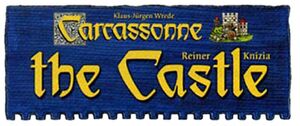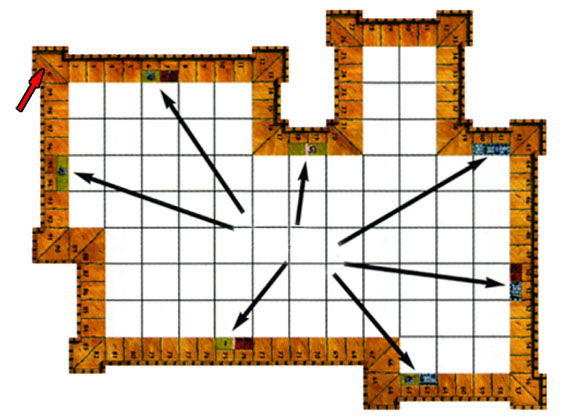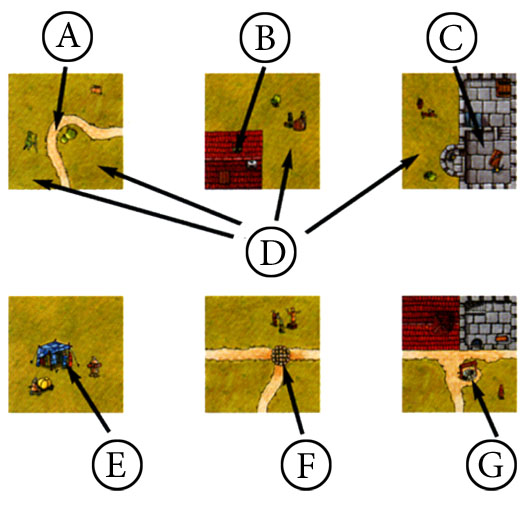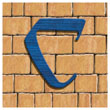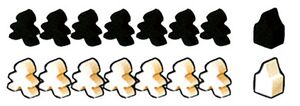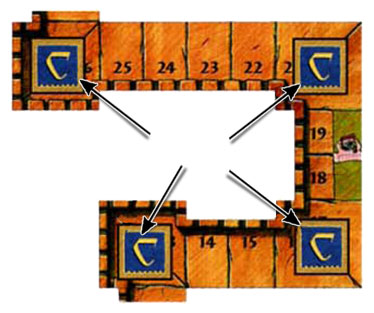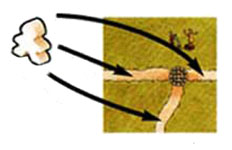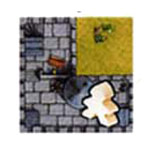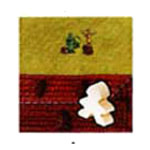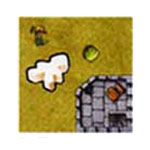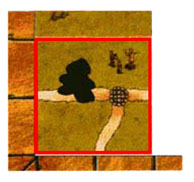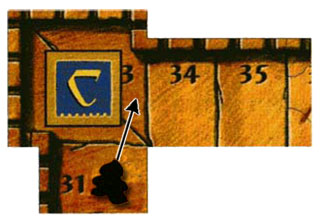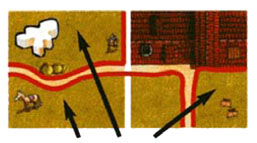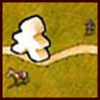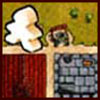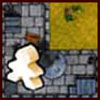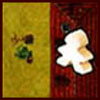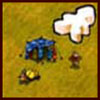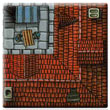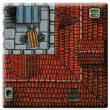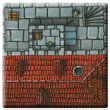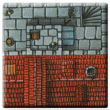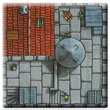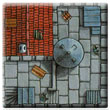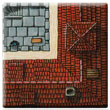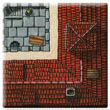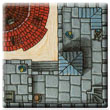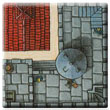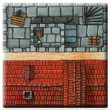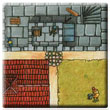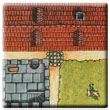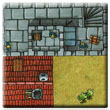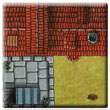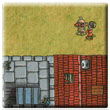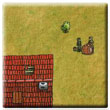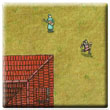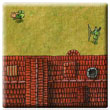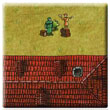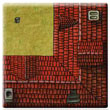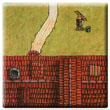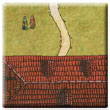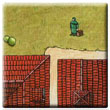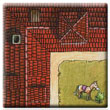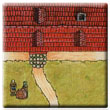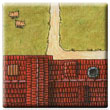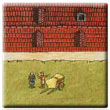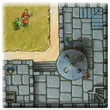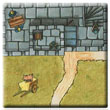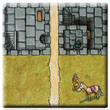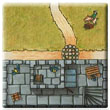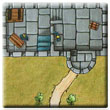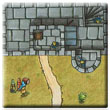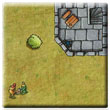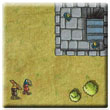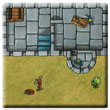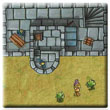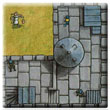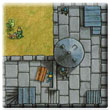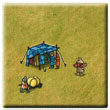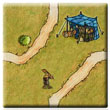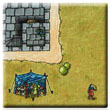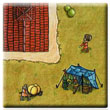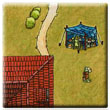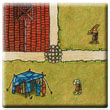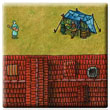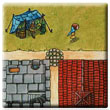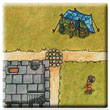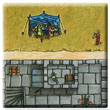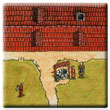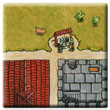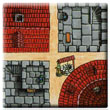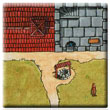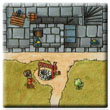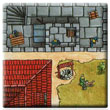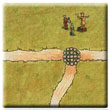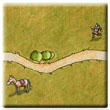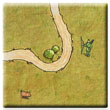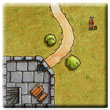The Castle Base Game
 |
You are reading rules for this design of tiles. |  |
| If your tiles have this design, then you have regular Carcassonne tiles. |  |
| If your tiles have different design, then choose game from Spin-offs. |  |
General info and comments
Originally released by Hans im Glück in 2003, Carcassonne: The Castle is an exciting tile-laying game for 2 players, ages 8 and up. Designed by Reiner Knizia, it is based on the Carcassonne game system from Klaus Jürgen Wrede.
The imposing silhouette of the city of Carcassonne sits like a throne in the light of the setting sun. Knights guard the towers, the squires live in houses, merchants loudly tout their wares, and the heralds carry the news throughout the city. Over all this bustle, the high castle looms behind its impenetrable walls.
Contents
- 1 castle wall in 10 pieces which the players put together like a puzzle before each game
- 60 castle tiles
- 18 wall tiles (two of each tile pictured)
- 14 followers in 2 colours, and 2 keeps in 2 colours
The goal
Turn by turn, the players place castle tiles within the castle walls. Thereby, they create paths, towers, houses, and courts, on which they place their followers in order to score points. Players score points during, and at the end of, the game. The player with the most points at the end is the winner!
Preparation
Put the castle wall together, piece by piece, so that the numbers along the top of the wall run from 0 to 99.
Shuffle the 60 castle tiles [1] face down and place them in stacks outside the castle walls on the table in easy reach of the players.
Shuffle the 18 wall tiles face down. Place one wall tile face down (without looking at it) on each corner tower space on the castle wall (except for corner tower "0/1"). Place unused wall tiles face down in the box without looking at them. They will not be used in the game.
Each player chooses a colour and takes the 7 followers and keep in that colour and places 1 follower as a scoring marker on space 0 of the scoring track. Each player puts their remaining followers and keep in their play area (the area on the table in front of them). The players decide between themselves who will start the game.
Playing the game
The players alternate turns starting with the starting player. On a player's turn, they take the following actions in the order shown below :-
- The player must draw a castle tile from one of the face-down stacks and place it within the castle.
- The player may place one of the followers from their supply on the tile just placed.
- If, with the placement of the tile, the player completed a path, tower, and/or house, the players must now score the completed feature.
- When a player, after scoring, has moved their scoring marker to a corner tower space on the castle wall, they immediately take the wall tile from that space, if it is still there.
Draw and place a castle tile
As the first action of a player's turn, the player must draw a castle tile from one of the face-down stacks. The player should show it to their opponent (who may offer placement advice) by putting it face-up in their play area. Then, the player must do the following :-
- The first castle tile placed in the game must be placed with one side placed completely next to any of the seven start spaces along the castle wall.
- Each further tile placed (shown in the examples with a red border) must be placed with one side completely next to a start space along the castle wall, or with at least one side completely next to a previously placed tile. Placing a tile only corner to corner, or half tile on half tile is not allowed.
- The paths must always be continued when they touch the edge of a tile [2]. The other castle features (tower, house, or court) may be placed next to each other in any combination desired.
- Any castle feature (path, tower, house, or court) may be placed next to the castle wall.
- If there is no legal place for a drawn tile (and both players agree) the tile is placed in the box (out of the game) and the player draws a new tile to place.
Place a follower
After placing a castle tile, the player may place one of their followers. To do so :-
- a player may only place 1 follower per turn
- the player must take the follower from their supply
- the player may only place the follower on the tile just placed
- the player must choose which feature of the castle tile to place the follower on - either as a ...
| or as a | or as a | or as a | ||||
| Herald on a path | Knight on a tower | Squire on a house | Merchant on a court (with or without market) |
- each new castle tile can enlarge an already existing path, tower, house or court. If there is already a follower (even the player's own) on the enlarged castle feature, the player may not place a follower on that feature. It matters not how far away the other follower is. Below are examples of allowed and disallowed follower placement :-
It is possible in the course of the game, however, for there to be more than one squire on a house, more than one knight on a tower, more than one herald on a path, and more than one merchant on a court. See Connecting paths, towers, houses and courts.
If a player has no followers in their supply, the player may not place one. However, players get their followers back during the game when features are completed and scored.
If the player did not complete a path, tower, or house, the player's turn is over and the opponent takes their turn.
Scoring completed paths, towers and houses
If, by placing the castle tile, the player completed a path, tower or house, the players now score the completed feature(s). Courts are not scored during the game - they are scored at the end of the game.
A completed path
A path is complete when the connected path segments [3] end in squares, the castle walls, buildings [4], or when the path becomes a closed loop. There is no limit to the length of a path; it can wander across many castle tiles and can branch and so have more than two ends.
The player with the most heralds on the completed path scores points for the path. The player scores 1 point for each castle tile (not each path segment) that is on the path. If the path includes a path segment on a start space, this counts as 1 point as though it were a castle tile.
The player moves their scoring marker along the castle wall scoring track to record the points scored. The scoring track runs around the castle walls for 100 spaces. When a player moves their scoring marker past space 99, the player continues to space 0, laying the scoring marker on its side to note that it has passed 100 points.
If there are one or more fountains along the completed path, the player scores 2 points for each castle tile on the completed path. Even if a path has several fountains, it still scores 2 points for each castle tile.
A completed tower
A tower is complete when the connected tower segments are completely surrounded by paths, houses, courts, and the castle wall (and the tower contains no empty spaces). There is no limit to the size of a tower. It can consist of many castle tiles.
The player with the most knights on the completed tower scores points for the tower. The player scores 2 points for each castle tile (not each segment) that forms the tower. If the tower includes a tower segment on a start space, this counts 2 points as though it were a castle tile.
A completed house and the keep
A house is complete when the connected house segments are completely surrounded by paths, towers, courts and the castle wall (and the house contains no empty spaces). There is no limit to the size of a house. It can consist of many castle tiles.
The player with the most squires on a completed house scores points for the house. The players scores 1 point for each castle tile (not each house segment that forms the house). If the house includes a house segment on a start space, this counts 1 point as though it were a castle tile.
When a player scores their first house, the player places their keep on it. If, later in the game, the player scores a larger house (the player has the most squires on a completed house) than the one on which the player's keep stands, the player moves their keep to the larger house. Thus, at the end of the game, each player's keep marks the largest house that they have completed.
Connecting paths, towers, houses and courts
By placing castle tiles, players may connect separate features that have followers on them.
By connecting such features, players can create
- a path with more than one herald
- a tower with more than one knight
- a house with more than one squire, or
- a court with more than one merchant
When scoring a completed path, tower, or house, the players first check to see if one player has more followers on the completed features than the other. If so, this player scores all the points for the feature alone. If both players have the same number of followers on the completed feature, neither scores the points for the completed feature.

Note: having several followers on a feature as described above does not contradict the rule "If there is already a follower (even the player's own) on the enlarged feature, the player may not place a follower on that feature". This rule is for the placing of followers! In the case above, features with followers that were originally placed on separated features are now connected. Thus, after the connection, the followers are on the same feature. Players may even plan their moves with future connections in mind.
The return of followers to their owners
After a path, tower, or house is completed and scored - and only then - the players take back their followers from the feature scored, putting them in their supplies. The followers are returned to the player's supply at the end of the turn. Thus they are available on the player's next turn and may be used in any role.
It is possible in a single turn for a player to place a follower, score the feature it is on, and take back the follower into their supply. To do this, a player must (always in this order) :-
- Place a new castle tile, completing a path, tower or house
- Place a follower on the completed path, tower or house
- Score the completed path, tower or house
- Take back the follower from the scored path, tower or house
The wall tiles
When, as a result of scoring, a player moves their scoring marker to either of the two spaces on a corner tower of the castle wall scoring track, the player takes the wall tile lying there (if it is still there) and places it face up in their play area. When a player moves their scoring marker past the corner, the player does not take a wall tile as they pass [5].
A player may use a wall tile, taken in this turn, on the next turn or any later turn, depending on which tile it is. On their turn [6], a player may use one or more wall tiles. Once played, a wall tile is removed from the game. For a complete description of the wall tiles, see the later section Description of Wall Tiles.
When taking a wall tile, the following is important: When the placement of a castle tile results in more than one completed feature, the player placing the tile scores their completed features first. If there is more than one feature to score for the player or their opponent, the placing player decides the order. [7]
The court
Courts are separated from each other by paths, towers and houses. When a player places a merchant on a court, it is placed on its side to emphasize that it cannot be returned to the player during the game. Courts are only scored at the end of the game.
End of a player's turn
After scoring and taking appropriate wall tiles from the scoring track, the player's turn is over, and their opponent then takes their turn.
Game End
The game ends at the end of the turn when the last castle tile is placed.
Remove all remaining wall tiles from the castle wall and then perform the final scoring.
Final scoring (scoring the keep, courts and wall tiles)
During final scoring, the players score the largest keep and the courts.
Also, the players can now use wall tiles 4 through 9. Incomplete paths, towers and houses are not scored! Exception: players who have wall tiles 4, 5 or 6.
Scoring the largest keep
The player with the largest keep (the player with the largest completed house [8]) scores the following points.
There will be at least 16 empty spaces within the castle walls at the end of the game. The players determine which connected area of empty spaces is the largest and count the number of castle tiles that would fit in this area [9]. The player with the largest keep scores this number of points by moving their scoring marker on the scoring track. If both players tie for the largest keep, neither scores for it. Note: wall tile 8!
Scoring the courts
The player with the most merchants on a court space [10] scores 3 points for each market on the court. If both players have the same number of merchants on a court, neither scores points for the court.
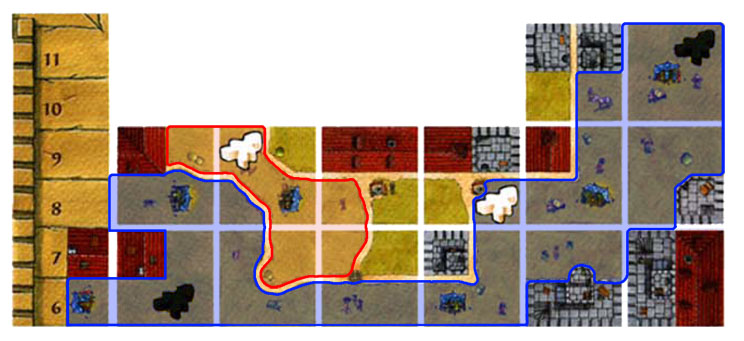
There are 5 markets on the large court, including the one on the start space next to the castle wall. Black has the most merchants on the large court. Black scores 15 points and moves their scoring marker on the scoring track. White scores nothing for this court. If black has wall tile 7, each market on the court would be worth 4 points for a total of 20 points.
Finally, players score points for wall tiles 4, 5, 6 (for incomplete features), and 9, if they have them.
The player with the most points is the winner.
Description of wall tiles
1 
|
The player takes another complete turn (during the game) [11] | 6 
|
The player scores 1 point per tile for 1 incomplete house (at game end) |
2 
|
The player doubles the score of 1 completed tower when scoring it (each tile = 4 points) [12] | 7 
|
The player scores 4 points for each market on 1 court (at game end) |
3 
|
The player doubles the score of 1 completed house when scoring it (each tile = 2 points) [13] | 8 
|
The player enlarges their keep by 2 tiles (at game end). For example, a keep of 5 tiles is counted as a keep of 7 tiles |
4 
|
The player scores 1 point per tile (2 with a fountain [14]) for 1 incomplete path (at game end) | 9 
|
The player scores 5 points (at game end) |
5 
|
The player scores 2 points per tile for 1 incomplete tower (at game end) | ||
| Tiles 1-3 are played during the game.
Tiles 4-9 are played at the end of the game. To play wall tiles 2-7, the player must have more followers on the feature than their opponent. Designer's clarifications for when an individual player holds both of a specific wall tile: [15]
| |||
Scoring Summary
| Point Table | ||||
| path | path (with fountain) |
tower | house | market |
| 1 | 2 | 2 | 1 | 3 |
House Rules
- Collecting wall tiles: You only can pick up a wall tile if you land on the corner space at the end of all that turn's scoring moves.
Tile Distribution
Total Regular Tiles: 60
Total Wall Tiles: 18
Footnotes
For Icons explanation and licensing please visit Icons page.
- ↑
 The term "Castle Tiles" refers to all the tiles placed within the castle walls during the game.
The term "Castle Tiles" refers to all the tiles placed within the castle walls during the game.
- ↑
 When some combinations of tiles with paths are placed together, the roads don't connect. This is just that the artwork/printing is slightly off, and not that the paths end.
When some combinations of tiles with paths are placed together, the roads don't connect. This is just that the artwork/printing is slightly off, and not that the paths end.
- ↑
 Points are scored only when ALL branches of a path have an end. Some paths can get pretty long, with multiple branches, in this game.
Points are scored only when ALL branches of a path have an end. Some paths can get pretty long, with multiple branches, in this game.
- ↑
 Paths must only connect to paths (or castle walls). You may not block off a path using a house, or tower, tile edge.
Paths must only connect to paths (or castle walls). You may not block off a path using a house, or tower, tile edge.
- ↑
 If you score 100 points before the game ends, passing 0 on the scoretrack, and then land on a missed wall tile from the first time round, you can you still pick it up.
If you score 100 points before the game ends, passing 0 on the scoretrack, and then land on a missed wall tile from the first time round, you can you still pick it up.
- ↑
 You may not play them during your opponent's turn, even though your opponent completes a feature for which you score.
You may not play them during your opponent's turn, even though your opponent completes a feature for which you score.
- ↑
 Each feature is scored separately, so the order in which they are scored can be important if it is possible to land on a tower segment with a wall tile with the first.
Each feature is scored separately, so the order in which they are scored can be important if it is possible to land on a tower segment with a wall tile with the first.
- ↑
 The rules don't say what "largest" means. Since all scoring is by tile, it is probably safe to assume that it is by the number of tiles, rather than the overall footprint (as measured in the number of quarter tiles).
The rules don't say what "largest" means. Since all scoring is by tile, it is probably safe to assume that it is by the number of tiles, rather than the overall footprint (as measured in the number of quarter tiles).
- ↑
 Castle wall start spaces, that have not had tiles placed against them, may be included when counting up the size of your keep.
Castle wall start spaces, that have not had tiles placed against them, may be included when counting up the size of your keep.
- ↑
 The boundary of each court is whatever it is surrounded by at this time: paths, towers, houses, castle walls, and the edge of the tile.
The boundary of each court is whatever it is surrounded by at this time: paths, towers, houses, castle walls, and the edge of the tile.
- ↑
 It is normal to play it during the turn you win it (after you remove and score the meeple that won it). You simply take another turn before your opponent gets their turn. But there is nothing to stop you saving it to use later. You could even have two bonus turns at the same time if you are lucky enough to get them both.
It is normal to play it during the turn you win it (after you remove and score the meeple that won it). You simply take another turn before your opponent gets their turn. But there is nothing to stop you saving it to use later. You could even have two bonus turns at the same time if you are lucky enough to get them both.
- ↑
 If you collect this tile when scoring a tower you may not use it immediately to boost the score of that tower. It must be used on a later turn.
If you collect this tile when scoring a tower you may not use it immediately to boost the score of that tower. It must be used on a later turn.
- ↑
 If you collect this tile when scoring a house you may not use it immediately to boost the score of that house. It must be used on a later turn.
If you collect this tile when scoring a house you may not use it immediately to boost the score of that house. It must be used on a later turn.
- ↑
 Scoring 2 points for an incomplete path was only introduced in the RGG version of the English rules. In the original German rules, and others including the 2020 Polish Zamek release, an incomplete path or road is worth 1 point per tile (whether it has a fountain on it, or not). This has also been confirmed by the designer.
Scoring 2 points for an incomplete path was only introduced in the RGG version of the English rules. In the original German rules, and others including the 2020 Polish Zamek release, an incomplete path or road is worth 1 point per tile (whether it has a fountain on it, or not). This has also been confirmed by the designer.
- ↑
 Source: Third hand via BGG
Source: Third hand via BGG
